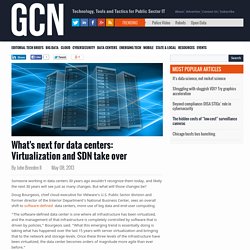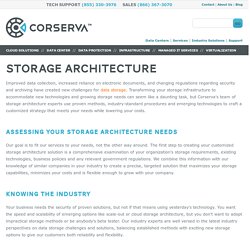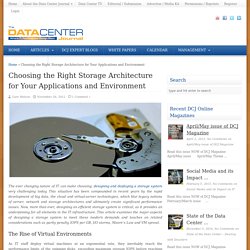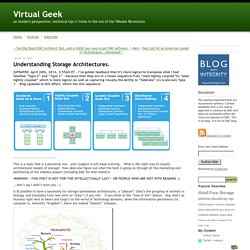

What's next for data centers: Virtualization and SDN take over. What's next for data centers: Virtualization and SDN take over Someone working in data centers 30 years ago wouldn't recognize them today, and likely the next 30 years will see just as many changes.

But what will those changes be? Doug Bourgeois, chief cloud executive for VMware's U.S. Public Sector division and former director of the Interior Department's National Business Center, sees an overall shift to software-defined data centers, more use of big data and end-user computing. "The software-defined data center is one where all infrastructure has been virtualized, and the management of that infrastructure is completely controlled by software that is driven by policies," Bourgeois said.
Other experts in the field agree. The impact will extend beyond data centers to the “end user experience in areas including mobility, BYOD and social [media],” said Anthony Robbins, vice president of federal sales for Brocade. All of this will be combined in what Daniel Kent calls the “intercloud.” Data Center & Server Virtualization for Cloud Infrastructure: VMware. Storage Architecture - Cloud Storage Architecture. Improved data collection, increased reliance on electronic documents, and changing regulations regarding security and archiving have created new challenges for data storage.

Transforming your storage infrastructure to accommodate new technologies and growing storage needs can seem like a daunting task, but Corserva's team of storage architecture experts use proven methods, industry-standard procedures and emerging technologies to craft a customized strategy that meets your needs while lowering your costs. Assessing Your Storage Architecture Needs Our goal is to fit our services to your needs, not the other way around. The first step to creating your customized storage architecture solution is a comprehensive examination of your organization's storage requirements, existing technologies, business policies and any relevant government regulations. Knowing the Industry Your business needs the security of proven solutions, but not if that means using yesterday's technology. Backup Solutions. The Rise of Data Protection Storage Architecture - Infographic. Pure Storage 101: Scale-up or Scale-out? - The Virtual Storage Guy.
Often we geeks will propound and pontificate on technical topics based on what I call ‘the vacuum of hypothetical merits’.

Understanding and considering the potentials and shortcomings satisfy our intellectual curiosity and fuel our passion – however often these conversations are absent of business objectives and practical considerations (like features that are shipping versus those that are in development). Mark twain once said, “Give a man a reputation as an early riser and he can sleep ’til noon.” The significance of this quote often comes to mind during technical comparisons. Consider scale-up and scale-out storage architectures. Likely you have an opinion on each but before diving into the vacuum what’s do you want from your storage infrastructure? The Ideal Storage Architecture Enterprise IT departments are in the midst of a transition from technology operator to IT services provider, where ensuring a high quality customer experience is paramount.
The Data Center JournalChoosing the Right Storage Architecture for Your Applications and Environment. The ever changing nature of IT can make choosing, designing and deploying a storage system very challenging today.

This situation has been compounded in recent years by the rapid development of big data, the cloud and virtual-server technologies, which blur legacy notions of server, network and storage architectures and ultimately create significant performance issues. Now, more than ever, designing an efficient storage system is critical, as it provides an underpinning for all elements in the IT infrastructure. This article examines the major aspects of designing a storage system to meet these modern demands and touches on related considerations such as parity penalty, IOPS per GB, I/O storms, Moore’s Law and VM sprawl.
The Rise of Virtual Environments As IT staff deploy virtual machines at an exponential rate, they inevitably reach the performance limits of the spinning disks, exceeding maximum storage IOPS before reaching maximum capacity.
Virtual storage architecture. Traditional storage architecture. Ten Properties of the Perfect Big Data Storage Architecture. Chapter 3. Storage Architecture. In this chapter, the Red Hat Enterprise Virtualization storage architecture is divided into components, roles, attributes, and functionalities.

The storage components are the logical building blocks of the architecture. The storage pool manager is a role held by a host that empowers it to manage structural changes to a data domain. Storage Architecture Guides - on StorageSearch.com. Storage standards are weak standards that are driven by component considerations.

Network standards are strong standards that are driven by system considerations A weak standard for Direct Attached Storage (DAS) Today, greater than 95% of all computer storage devices such as disk drives, disk arrays and RAID systems are directly attached to a client computer through various adapters with standardized software protocols such as SCSI, Fibre Channel and others. Storage_architecture_and_challenges.pdf. Understanding Storage Architectures. [UPDATED: April 28th, 2014, 2:55am ET – I’ve gotten feedback that it’s more logical to transpose what I had labelled “Type 2” and “Type 3” – because then they are in a linear sequence from “most tightly coupled”to “least tightly coupled” which is more logical (as well as capturing visually the ability to “federate” (vs scale-out) Type 1.

Blog updated to this effect, which has this sequence: This is a topic that is a perennial one – and I suspect it will keep evolving. What is the right way to classify architectural models of storage? How does one figure out what the heck is going on through all the marketing and positioning of the industry players (including EMC for that matter)? … Don’t say I didn’t warn you :-) It IS possible to have a taxonomy for storage/persistence architectures, a “phylum” (that’s the grouping of animals in biology, and translates from new latin as “class”) if you will. This isn’t a new topic (people that know me are perhaps sick of it :-).